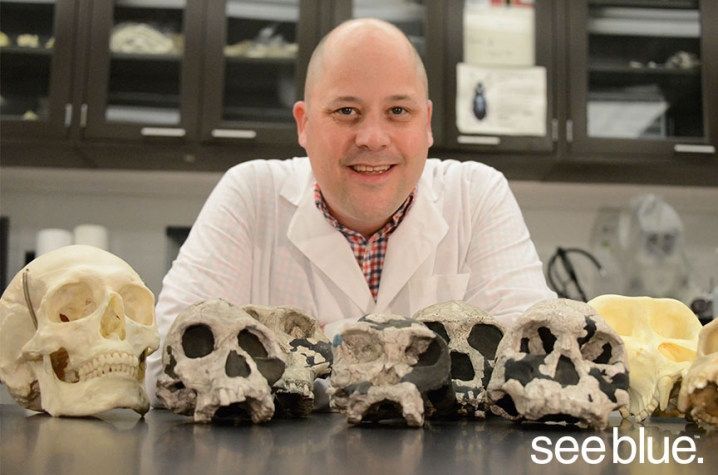UK Professor Part of International Team to Describe New Fossil Human Species
LEXINGTON, Ky. (Sept. 16, 2015) — In the fall of 2013, a recreational caver in the Rising Star cave system near Johannesburg, South Africa, happened upon the nearly complete fossil remains of as many as 15 individuals representing a new fossil human species – Homo naledi. This new species shares many features with early members of the genus Homo, the genus to which modern humans (Homo sapiens) also belong.
For paleontologists who study the morphological evidence of human evolution, this new discovery afforded the rare opportunity to study a nearly complete set of fossils belonging to a previously unknown human ancestor. With more than 1,500 fossils — the largest find of its kind on the African continent — the discovery of H. naledi provides valuable new insights into the origins of and variation within the genus Homo.
In an effort to describe the fossils and disseminate the new information associated with this discovery, Lee Berger, the lead researcher at the University of Witwatersrand who heads the Rising Star Expedition, organized a global team of more than 30 paleontology experts tasked with studying the fossilized remains. Andrew Deane, a University of Kentucky associate professor of anatomy and neurobiology, was recruited to help describe the extensive sample of fossils associated with the hand and foot. Deane’s research uses 2-D and 3-D morphometric analyses to replicate how these early humans might have used their hands and feet to navigate and interact with their environments.
Deane was specifically interested in the length, shape and curvature of the finger and toes bones, and what their anatomy suggested about whether H. naledi climbed trees to find food and seek protection. His observations were part of the formal description of H. naledi, which identifies the species as morphologically similar to the earliest members of the genus Homo. The University of the Witwatersrand, the National Geographic Society and the South African National Research Foundation announced the new species in two papers published in the online journal eLife on Sept. 10.
“The sheer volume of material recovered from the Rising Star cave representing this new species is remarkable,” Deane said of the excavation. “This is the largest fossil find of this kind, and all parts of the skeleton are represented in some form or fashion. Even famous fossils like Lucy, an early human ancestor in the Australopithecus group, are not nearly as complete and well represented as this species.”
Deane traveled to Johannesburg in May 2014 after receiving an invitation to participate in the Rising Star Expedition. A team of more than 30 international experts waded through the sizeable fossil sample for eight weeks in a united effort to describe the species. Deane, who specializes in reconstructing the paleobiology of fossil apes and early humans, used 3-D laser scanning technology to catalogue and describe the hundreds of H. naledi hand and foot bones recovered from Rising Star cave.
At odds with romanticized version of paleontology seen in movies, Deane completed most of his research at the University of Witwatersrand using a computer equipped with a 3-D laser scanner to generate 3-D models of the H. naledi hand and foot bones. Special 3-D editing software enabled Deane to conduct detailed morphometric analyses of the hand and foot morphology. Using his knowledge of the hand and foot anatomy of living apes and modern humans, Deane was able to make inferences about how H. naledi would have used its hands and feet, and, more specifically, if H. naledi spent appreciable amounts of time climbing trees.
Deane found that the finger and toe bones were elongated and curved, which is consistent with the interpretation that H. naledi could have regularly climbed trees. The wrist bones, thumb and the parts of the foot, aside from the toes, were distinctly modern and similar to modern humans. Deane describes the juxtaposition of the primitive finger and toe anatomy with the more modern wrist and foot anatomy as “mosaic.”
“Mosaic evolution in the hominin lineage is the rule and not the exception,” Deane said. “The transition from an ape-like to a modern human skeleton does not happen uniformly, and this new species is no exception.”
Other skeletal structures described for H. naledi, like the pelvis, cranium and upper limb, were also found to preserve a combination of primitive and modern traits, although Deane said a specific pattern of modern parts and primitive parts seem to differentiate H. naledi.
“This demonstrates that the fossil record of our genus is a lot more complex and diverse than we once thought it was and that our evolutionary backstory has more morphological plot-twists and turns” Deane said.
Deane said this discovery will have significant implications for how scientists interpret the more recent evolutionary past of the human species.
“No matter how we slice it, this find means there are more species and there is more morphological variability in the fossil record of the genus Homo," Deane said. This means that just like other animals, our evolution was a lot more like a bush with lots of branches. Some of these branches lead to other branches, but some of them are dead ends. Finds like this provide valuable new clues to help answer questions about why some of these branches were successful and some were not and which branches might have lead to the origins of our own species.”
To read the full journal article, click here.
MEDIA CONTACT: Elizabeth Adams, elizabethadams@uky.edu





